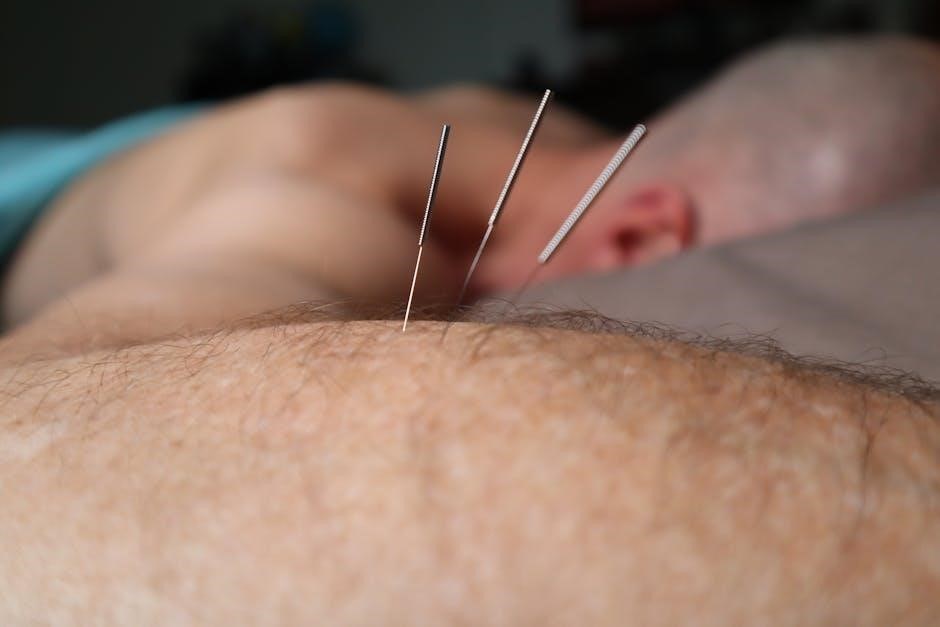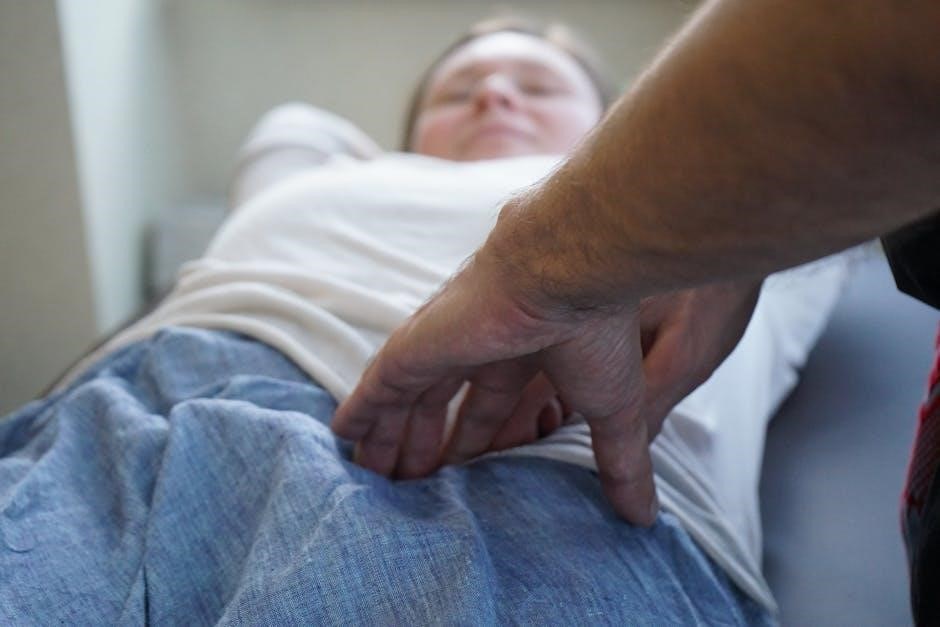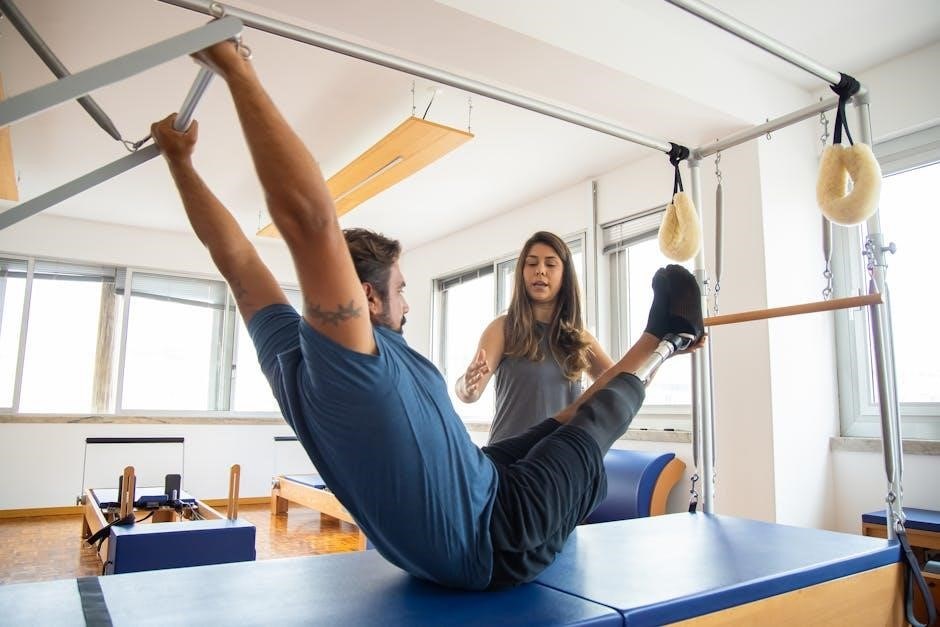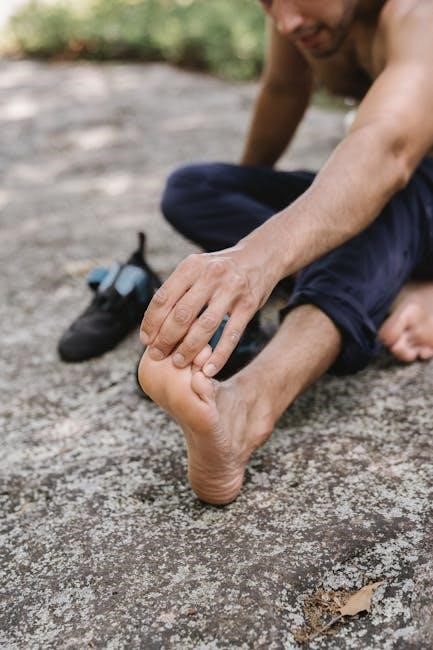anterior hip precautions physical therapy pdf
The Anterior Hip Replacement is a minimally invasive surgical approach that accesses the hip joint through the front of the hip, preserving muscles and tendons.
1.1 What is Anterior Hip Replacement?
The Anterior Hip Replacement is a surgical procedure where the hip joint is accessed through an incision at the front of the hip. This minimally invasive approach aims to preserve muscles and tendons, reducing tissue damage. It allows for smaller incisions, less postoperative pain, and faster recovery compared to traditional methods. The procedure is designed to restore hip function and mobility while minimizing complications, making it a preferred choice for many patients undergoing hip surgery.
1.2 Benefits of the Anterior Approach
The Anterior Approach offers several advantages, including reduced muscle damage, faster recovery, and less postoperative pain. Patients typically experience shorter hospital stays and fewer complications. This minimally invasive technique allows for smaller incisions and preservation of key tissues, promoting better mobility. The anterior approach also enables patients to return to daily activities and work sooner, making it a preferred choice for many undergoing hip replacement surgery due to its overall effectiveness and patient-friendly outcomes.

Importance of Physical Therapy After Anterior Hip Replacement
Physical therapy is crucial for regaining strength, mobility, and function after anterior hip replacement. It helps patients recover faster, prevents complications, and ensures proper healing and alignment.
2.1 Role of Physical Therapy in Recovery
Physical therapy plays a vital role in recovery after anterior hip replacement, starting immediately post-surgery. Therapists guide patients through exercises to restore strength, mobility, and functionality. They teach the use of walkers or crutches and provide exercises to perform while in bed. Early mobilization is a key focus, helping patients regain independence and reduce recovery time. Compliance with physical therapy routines is essential for achieving a successful and efficient recovery, ensuring the hip heals properly and functions optimally.
2.2 Goals of Physical Therapy
The primary goals of physical therapy after anterior hip replacement are to restore strength, improve mobility, and ensure safe, functional movement. Therapy focuses on helping patients regain independence in daily activities, avoid complications, and achieve long-term hip health. A tailored program addresses individual needs, emphasizing proper movement techniques and exercises to prevent dislocation and promote recovery. Compliance with these goals ensures a successful outcome and optimal return to normal activities.

Anterior Hip Precautions
Anterior hip precautions are essential to prevent dislocation and ensure proper healing after surgery, focusing on safe movements and avoiding high-risk positions to protect the new hip joint.
3.1 Key Precautions to Prevent Dislocation
To prevent dislocation after anterior hip replacement, avoid bending past 90 degrees, crossing your legs, or turning your operated leg inward. Use a walker or crutches for stability and follow weight-bearing guidelines. Avoid sitting in low chairs or twisting movements. Keep your hip in a safe range of motion, typically between 0 and 90 degrees of flexion, to minimize dislocation risks during the healing process.
3.2 Safe Positions for the Hip
Safe positions for the hip after anterior replacement include sitting with a 90-degree bend, using a supportive pillow to maintain alignment. When lying down, place a pillow between your legs to prevent inward turning. Avoid crossing your legs or bending past 90 degrees. Standing and walking with assistive devices, like a walker, helps maintain proper posture and reduces strain on the hip joint during the healing process.
3.3 Activities to Avoid
After anterior hip replacement, avoid activities that bend your hip past 90 degrees, such as deep squatting or crossing your legs. Refrain from heavy lifting, twisting, or high-impact exercises. Avoid pivoting on the affected leg and ensure proper posture to prevent strain; Crossing your legs or ankles while sitting or lying down should also be avoided to minimize dislocation risk. These precautions are vital during the early healing phase to ensure proper recovery and joint stability.
Role of a Physical Therapist in Anterior Hip Recovery
A physical therapist guides patients through safe movements, develops personalized exercise plans, and ensures compliance with precautions to promote optimal recovery and restore mobility.
4.1 Guidance on Safe Movements
Physical therapists provide detailed instructions on safe movements to avoid hip dislocation, emphasizing proper posture, bending, and walking techniques. They teach patients to use assistive devices like walkers or crutches correctly and demonstrate exercises that strengthen the hip without jeopardizing recovery. The focus is on minimizing strain and ensuring patients understand their movement limitations. This guidance is tailored to individual needs and surgical specifics, fostering confidence and safety during daily activities. Compliance with these instructions is crucial for optimal outcomes.
4.2 Customized Exercise Programs
Physical therapists design personalized exercise plans based on the patient’s specific needs, focusing on strengthening muscles, improving mobility, and restoring functional movement. These programs address weak areas and promote proper gait mechanics. Exercises are gradually progressed to ensure safe and effective recovery. The tailored approach helps patients achieve their recovery goals while adhering to hip precautions, minimizing the risk of complications. Regular progress assessments allow adjustments to maintain optimal outcomes and patient motivation.

Phases of Physical Therapy After Anterior Hip Replacement
The physical therapy process is divided into structured phases, focusing on immediate recovery, early mobilization, strengthening, and advanced mobility to restore full hip function and patient independence.
5.1 Immediate Post-Surgery Phase
After surgery, once anesthesia wears off, nurses and physical therapists assist patients in getting out of bed, focusing on initial mobility and safety. Patients learn to use walkers or crutches to avoid dislocation and promote healing. Gentle exercises, such as leg lifts and ankle pumps, are introduced to improve circulation and maintain range of motion. This phase emphasizes pain management, wound care, and adherence to hip precautions to ensure a stable foundation for recovery.
5.2 Early Mobilization Phase
During this phase, patients begin gentle exercises to improve circulation and strength, focusing on hip precautions to prevent dislocation. Physical therapists guide patients in using assistive devices like walkers or crutches. Activities include seated exercises, leg lifts, and short walks to promote healing and mobility; The goal is to transition from bed to chair and eventually to short walks, ensuring patients can perform basic daily activities safely while adhering to their hip precautions.
5.3 Intermediate Phase
In this phase, patients progress to more dynamic exercises, focusing on strengthening hip muscles and improving balance. Physical therapists introduce low-impact activities like swimming or cycling, ensuring adherence to hip precautions. The goal is to enhance functional mobility and prepare for daily activities without risking dislocation. Patients learn to perform tasks like climbing stairs and transitioning between surfaces safely. This phase builds strength and confidence, setting the foundation for advanced rehabilitation;
5.4 Advanced Phase
The advanced phase focuses on high-level exercises to restore full hip function and strength. Patients engage in dynamic balance training, agility drills, and functional movements. The goal is to transition to unrestricted activities while maintaining hip precautions. Physical therapists tailor exercises to address individual limitations, promoting long-term mobility and preventing future complications. This phase ensures patients are prepared for active lifestyles, with a strong emphasis on maintaining proper movement patterns and hip health.
Common Exercises in Anterior Hip Physical Therapy
Exercises focus on strengthening hip muscles, improving flexibility, and restoring proper movement patterns. They include glute bridges, straight-leg raises, and balance training to enhance hip stability and function.
6.1 Range of Motion Exercises
Range of motion exercises are essential to improve joint mobility and prevent stiffness after surgery. Common exercises include seated marching, supine hip flexion, and standing hip abduction. These movements help restore natural hip mechanics without dislocating the joint. Patients are guided to perform these exercises slowly and within prescribed limits to ensure safety and promote proper healing. These activities are often done with the assistance of a walker or other supportive devices to maintain balance and stability during recovery.
6.2 Strengthening Exercises
Strengthening exercises focus on improving muscle power around the hip joint to support stability and mobility. Common exercises include straight leg raises, glute bridges, and step-ups. These exercises target key muscle groups like the glutes, quads, and hamstrings. Patients may use resistance bands or light weights for added challenge. Strengthening is crucial for restoring normal hip function and preventing dislocation. A physical therapist tailors these exercises to individual needs, ensuring they are performed safely and effectively to promote long-term recovery and hip health.
6.3 Balance and Stability Exercises
Balance and stability exercises are essential for restoring hip function and preventing falls. Activities like single-leg standing, wobble board training, and heel-to-toe walking improve proprioception. These exercises enhance coordination and reduce the risk of dislocation. Patients often perform weighted shifts and balance reaches to strengthen stabilizing muscles. A physical therapist customizes these exercises to address individual needs, ensuring safe progression and optimal recovery outcomes. Consistency in practice helps patients regain confidence in their mobility post-surgery.

Functional Activities and Precautions
Patients learn safe ways to perform daily activities, such as sitting, standing, and bending, while avoiding high-risk movements to prevent hip dislocation and promote healing.
7.1 Safe Ways to Perform Daily Activities
Patients are taught to perform daily activities safely, such as sitting, standing, and bending, using assistive devices when necessary. Emphasis is placed on maintaining proper hip alignment and avoiding risky movements like crossing legs or turning the leg inward. Physical therapists guide patients in adapting these activities to prevent dislocation and ensure a smooth recovery.
7.2 Avoiding High-Risk Movements
Avoiding high-risk movements is crucial to prevent hip dislocation and ensure proper healing. Patients are advised to avoid crossing their legs, bending at the hips, or turning the operated leg inward. These movements can destabilize the hip joint. Physical therapists emphasize adherence to these precautions to minimize complications and promote a safe recovery. Following these guidelines helps patients maintain hip stability and avoid setbacks during the healing process.

Modifications for Individual Needs
Physical therapy plans and precautions may be tailored to address specific patient conditions, ensuring personalized recovery strategies and optimizing outcomes for each individual’s unique needs.
8.1 Adjustments for Different Patient Conditions
Physical therapy plans are tailored to accommodate individual patient needs, such as age, weight, or pre-existing conditions. Adjustments may include modified exercises or additional support to ensure safety and effectiveness. For instance, patients with limited mobility may require simpler movements, while those with higher activity levels might need more challenging routines. These personalized modifications aim to optimize recovery outcomes and address unique challenges, ensuring each patient progresses at their own pace while adhering to hip precautions.
8.2 Special Considerations for Bilateral Replacements
Bilateral hip replacements require unique adjustments in physical therapy to address both hips simultaneously. Patients may need extended use of mobility aids and tailored exercises to restore function and strength in both hips. Recovery timelines may be longer, and therapy plans must balance activity levels to avoid overexertion. Additionally, precautions are intensified to prevent dislocation in either hip, emphasizing controlled movements and gradual progression. Monitoring and adjustments are crucial to ensure proper healing and functional recovery for both joints.

Importance of Adhering to Precautions
Adhering to hip precautions is crucial to prevent dislocation and ensure proper healing. Non-compliance can lead to complications, prolonged recovery, and reduced hip functionality long-term.
9.1 Consequences of Not Following Precautions
Ignoring hip precautions can lead to serious complications, including dislocation, prolonged recovery, and increased risk of revision surgery. Dislocation is a primary concern, as it disrupts the healing process. Non-compliance may also result in increased pain, limited mobility, and reduced functionality of the hip joint. These complications can significantly delay overall recovery and negatively impact the surgical outcome, emphasizing the importance of strict adherence to guidelines provided by healthcare professionals.
9.2 Patient Compliance and Recovery Outcomes
Adhering to hip precautions and physical therapy guidelines is crucial for optimal recovery. Patient compliance ensures proper healing, reduces the risk of complications, and improves functional outcomes. Consistent participation in prescribed exercises strengthens the hip joint and restores mobility. Non-compliance can hinder progress, leading to prolonged recovery or additional medical interventions. Therefore, active engagement in the rehabilitation process significantly enhances the likelihood of a successful and sustainable recovery following anterior hip replacement surgery.

Outpatient Physical Therapy
Outpatient physical therapy begins after hospital discharge, focusing on exercises to improve mobility and strength. Patients continue their rehabilitation, gradually increasing activity levels for full recovery.
10.1 Transition to Outpatient Care
After hospital discharge, patients transition to outpatient physical therapy to continue their recovery. A physical therapist creates a personalized plan focusing on strengthening, mobility, and functional activities. Patients learn exercises to perform at home, ensuring consistent progress. Outpatient care also addresses any remaining limitations, helping patients gradually return to daily activities and independence. Regular follow-ups with the therapist monitor progress and adjust the program as needed for optimal recovery outcomes.
10.2 Continuing Exercises at Home
Continuing exercises at home is crucial for maintaining progress in recovery. Patients are provided with a structured routine, including range-of-motion and strengthening exercises, to perform daily. Adherence to hip precautions is emphasized to prevent dislocation. A physical therapist may recommend modifications based on individual recovery. Consistency in performing these exercises ensures improved mobility, strength, and functional ability, supporting a smooth transition to independence and long-term hip health.

Long-Term Recovery and Hip Health
Achieving full potential in long-term recovery involves maintaining hip strength, mobility, and adhering to lifelong precautions. Regular monitoring and a healthy lifestyle ensure optimal hip health.
11.1 Maintaining Hip Strength and Mobility
Maintaining hip strength and mobility is crucial for long-term recovery. Gentle exercises like swimming and cycling promote joint health without excessive strain. Strengthening muscles around the hip enhances stability and reduces wear. Regular physical therapy ensures proper mobility and prevents stiffness. Patients should avoid high-impact activities and adhere to their personalized exercise plans. Proper posture and weight management also contribute to long-term hip health. Consistent effort in maintaining strength and mobility ensures a successful and durable surgical outcome.
11.2 Lifelong Precautions and Monitoring
Lifelong precautions are essential to protect your hip replacement and ensure long-term success. While the anterior approach has fewer restrictions, certain movements, like excessive bending or twisting, should still be avoided. Regular monitoring by your surgeon and adherence to recommended activity levels are crucial. Patients must also be vigilant about infection risks and follow guidelines for antibiotics before procedures. Proper precautions and continuous monitoring help maintain the integrity of the hip replacement and prevent complications over time.
Successful recovery from anterior hip replacement requires adherence to physical therapy and precautions, ensuring enhanced mobility and minimizing complications for long-term hip health and functionality.
12.1 Summary of Key Points
Adherence to anterior hip precautions and physical therapy is crucial for minimizing complications and ensuring optimal recovery. Key points include avoiding high-risk movements, following personalized exercise programs, and maintaining safe hip positions. Patient compliance with these guidelines significantly impacts long-term hip health and functionality, emphasizing the importance of a structured rehabilitation plan tailored to individual needs.
12.2 Final Tips for Successful Recovery
Adhere strictly to anterior hip precautions to prevent dislocation and promote healing. Commit to your physical therapy program, as consistent effort yields the best outcomes. Maintain a healthy lifestyle, including proper nutrition and weight management, to support joint health. Use assistive devices as recommended and avoid high-risk movements. Regular follow-ups with your healthcare team ensure progress and address any concerns promptly. Stay informed and proactive in your recovery journey for long-term success and mobility.

Additional Resources
Downloadable PDF guides and recommended reading materials provide comprehensive insights into anterior hip replacement, precautions, and physical therapy, ensuring well-informed recovery and long-term hip health management.
13.1 Downloadable PDF Guides
Downloadable PDF guides provide detailed information on anterior hip replacement, including post-surgery precautions and physical therapy exercises. These resources often include visual aids like diagrams and step-by-step instructions to help patients understand proper recovery techniques. Many guides are created by orthopedic specialists and physical therapists, ensuring evidence-based content. Patients can access these materials online, offering convenient access to essential information for a successful recovery. These guides are invaluable for patients seeking to adhere to their treatment plans and maintain long-term hip health.
13.2 Recommended Reading and References
Recommended reading includes peer-reviewed journals, orthopedic society publications, and patient education materials. References such as the American Academy of Orthopaedic Surgeons (AAOS) guidelines and rehabilitation journals provide evidence-based insights. Patient-specific brochures and surgical guides are also valuable, offering detailed post-operative care instructions. These resources complement downloadable PDF guides, ensuring comprehensive understanding of anterior hip replacement and physical therapy protocols. They are essential for both patients and caregivers seeking reliable information to support recovery and long-term hip health.
